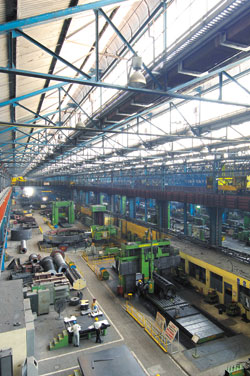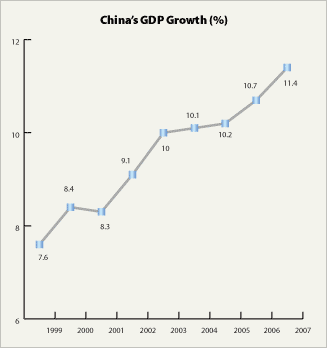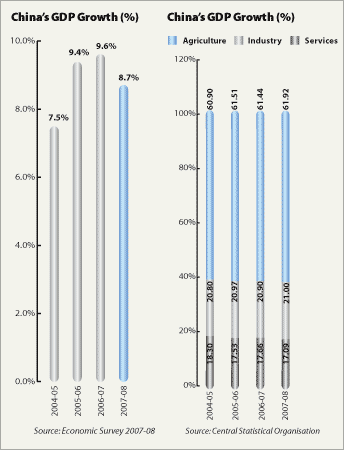Management Discussion & Analysis
Business Review
Established in 1907, Tata Steel completed 100 years in the financial year 2007-08. On 2nd April, 2007, the Company completed the acquisition of Corus Group plc, a Steel Company headquartered at UK for an Enterprise Value of USD 14.7 billion. Post the acquisition of Corus, Tata Steel Group is now the world’s 6th largest steel company with current steel deliveries of 32 million tonnes. Set up as Asia’s first integrated steel plant and India’s largest integrated private sector steel company, a century ago, it is now the world’s second most geographically diversified steel producer, with operations in 24 countries and commercial presence in over 50 countries. The Jamshedpur operations in India is increasing its capacity from 5 mtpa to 10 mtpa by end 2010 and the Company has also signed MoUs to set up four greenfield steel projects in the states of Jharkhand, Orissa and Chhattisgarh in India and one in Vietnam.
Few years back, Tata Steel embarked on a journey to pursue Growth and Globalisation through organic and inorganic strategy to increase its capacity in excess of 50 mtpa by 2015. The Company identified several strategic levers including building a stronger base in India, acquisitions in both growing and developed markets, strategic investments in raw material assets and focus on branding.
In the following section the performance and impact of the global and regional economies have been discussed:
1) Global economy
The financial markets in the last 12 months have been volatile triggered by the subprime mortgage crisis in the US. This has adversely affected the liquidity and the risk perception of the international capital markets. Inflation has increased around the World boosted by mainly increase in food and energy prices.
The real effective exchange rate for the US dollar has declined since mid-2007 as foreign investment in US bonds and equities has been dampened by reduced confidence in both the liquidity of and the returns on such assets, weakening of US growth prospects and interest rate cuts. The main counter part to the decline of the dollar has been appreciation of the euro, the yen, and other floating currencies such as the Canadian dollar and some emerging economy currencies.
In 2007, China’s GDP registered a growth of 11.4%. The industrial output in China has been growing progressively from 8.5% in 1999 18.5% in 2007. The country’s exports grew from 6.1% in 1999 to 25.7% in 2007 whereas the imports experienced a stable growth of 18.2% in 1999 to 10.8% in 2007.
Japan’s industrialised, social market economy is the world’s third-largest, adjusted to purchasing power parity (PPP), after the United States and People’s Republic of China.
As per the International Monetary Fund, Japan’s GDP growth rate will be maintained at around 2.3% in 2007 after expanding by 2.2% in 2006. The yen has fallen to near 20-year low, largely due to widening interest rate differentials with other currencies, as also due to the low volatility in foreign exchange markets.
2) UK & European Economy
Maintaining the growth trend of 2.9% in 2006, the UK economy recorded a growth of 3% in 2007, largely driven by consumption, business investment and residential construction. However, GDP growth slowed in the December 2007 and March 2008 quarters, due to falling residential construction and a slowdown in activity in the business and financial services sector, reflecting in part the impact of recent financial market turbulence.
GDP growth rate remained stable in the European Union (3.3% in 2006 and 3.1% in 2007). While the efficiency of labour and capital rose rapidly in the middle-income countries of the former Soviet Union (Russian GDP growth rate from 7.4% to 8.1%), the German economy featured a GDP growth of 2.5% in 2007 as compared to 2.9% in 2006. The weak private consumption in Germany in 2007 was partly offset by strong exports and investments.
3) Indian Economy
The economy of India, measured in USD exchange rate terms, is the fourth largest in the world, with a GDP of
USD 1.50 trillion in 2007. The Indian economy continued the high rate of growth for the third year in succession. The last three financial years in India saw growth rates of 9.4%, 9.6% and 8.7% (2007-08). There has been a deceleration in the growth rate in 2007-08 as compared to the last two financial years owing to the slowing down of the economy and inflationary pressures within India. The per capita income of India has more than doubled from USD 460 in 2000 to USD 1,089 in 2007. The primary contributor for the increase in the GDP has been the services sector led by communications (growth averaging 15.3% per annum for the last 5 years), with construction and transport following closely behind. The interest rates in India have risen in the recent years and the increase is evident through the prime lending rate, Long term Government Bond rates as well as the Bank rates. The Indian foreign exchange rate exhibited two-way movements during the year 2007-08. The Rupee appreciated against the USD by 5.6% from Rs. 43.59 in March 2007 to
Rs. 39.27 by early January 2008. In Q4 FY 2007-08, however, the Rupee depreciated easing to Rs. 39.97 per USD in March 2008. Overall, during FY 2007-08, the Rupee appreciated by 9.1% against the USD and 7.5% against the GBP but depreciated by 7.7% against the Japanese Yen and by 7.8% against the Euro.
4) South-East Asian Economy
The GDP of Singapore grew at a rate of 7.7% in 2007 which was lower than the growth rate of 8.2% in 2006. In Thailand, domestic demand was severely weakened by the high degree of political uncertainty in 2007, but the positive external balance helped in sustenance of the economy. The GDP growth rate was 4.8% in 2007 and is likely to remain at the same level in 2008 as well. While the Vietnamese economy was fuelled by expansion of the industrial and service sectors achieving a GDP growth rate of around 8%, the Indonesian economy buoyed by a recovery of investment, registered a GDP growth rate of around 6%.

 Established in 1907, Tata Steel completed 100 years in the financial year 2007-08. On 2nd April, 2007, the Company completed the acquisition of Corus Group plc, a Steel Company headquartered at UK for an Enterprise Value of USD 14.7 billion. Post the acquisition of Corus, Tata Steel Group is now the world’s 6th largest steel company with current steel deliveries of 32 million tonnes. Set up as Asia’s first integrated steel plant and India’s largest integrated private sector steel company, a century ago, it is now the world’s second most geographically diversified steel producer, with operations in 24 countries and commercial presence in over 50 countries. The Jamshedpur operations in India is increasing its capacity from 5 mtpa to 10 mtpa by end 2010 and the Company has also signed MoUs to set up four greenfield steel projects in the states of Jharkhand, Orissa and Chhattisgarh in India and one in Vietnam.
Established in 1907, Tata Steel completed 100 years in the financial year 2007-08. On 2nd April, 2007, the Company completed the acquisition of Corus Group plc, a Steel Company headquartered at UK for an Enterprise Value of USD 14.7 billion. Post the acquisition of Corus, Tata Steel Group is now the world’s 6th largest steel company with current steel deliveries of 32 million tonnes. Set up as Asia’s first integrated steel plant and India’s largest integrated private sector steel company, a century ago, it is now the world’s second most geographically diversified steel producer, with operations in 24 countries and commercial presence in over 50 countries. The Jamshedpur operations in India is increasing its capacity from 5 mtpa to 10 mtpa by end 2010 and the Company has also signed MoUs to set up four greenfield steel projects in the states of Jharkhand, Orissa and Chhattisgarh in India and one in Vietnam. The financial markets in the last 12 months have been volatile triggered by the subprime mortgage crisis in the US. This has adversely affected the liquidity and the risk perception of the international capital markets. Inflation has increased around the World boosted by mainly increase in food and energy prices.
The financial markets in the last 12 months have been volatile triggered by the subprime mortgage crisis in the US. This has adversely affected the liquidity and the risk perception of the international capital markets. Inflation has increased around the World boosted by mainly increase in food and energy prices. The economy of India, measured in USD exchange rate terms, is the fourth largest in the world, with a GDP of
USD 1.50 trillion in 2007. The Indian economy continued the high rate of growth for the third year in succession. The last three financial years in India saw growth rates of 9.4%, 9.6% and 8.7% (2007-08). There has been a deceleration in the growth rate in 2007-08 as compared to the last two financial years owing to the slowing down of the economy and inflationary pressures within India. The per capita income of India has more than doubled from USD 460 in 2000 to USD 1,089 in 2007. The primary contributor for the increase in the GDP has been the services sector led by communications (growth averaging 15.3% per annum for the last 5 years), with construction and transport following closely behind. The interest rates in India have risen in the recent years and the increase is evident through the prime lending rate, Long term Government Bond rates as well as the Bank rates. The Indian foreign exchange rate exhibited two-way movements during the year 2007-08. The Rupee appreciated against the USD by 5.6% from Rs. 43.59 in March 2007 to
Rs. 39.27 by early January 2008. In Q4 FY 2007-08, however, the Rupee depreciated easing to Rs. 39.97 per USD in March 2008. Overall, during FY 2007-08, the Rupee appreciated by 9.1% against the USD and 7.5% against the GBP but depreciated by 7.7% against the Japanese Yen and by 7.8% against the Euro.
The economy of India, measured in USD exchange rate terms, is the fourth largest in the world, with a GDP of
USD 1.50 trillion in 2007. The Indian economy continued the high rate of growth for the third year in succession. The last three financial years in India saw growth rates of 9.4%, 9.6% and 8.7% (2007-08). There has been a deceleration in the growth rate in 2007-08 as compared to the last two financial years owing to the slowing down of the economy and inflationary pressures within India. The per capita income of India has more than doubled from USD 460 in 2000 to USD 1,089 in 2007. The primary contributor for the increase in the GDP has been the services sector led by communications (growth averaging 15.3% per annum for the last 5 years), with construction and transport following closely behind. The interest rates in India have risen in the recent years and the increase is evident through the prime lending rate, Long term Government Bond rates as well as the Bank rates. The Indian foreign exchange rate exhibited two-way movements during the year 2007-08. The Rupee appreciated against the USD by 5.6% from Rs. 43.59 in March 2007 to
Rs. 39.27 by early January 2008. In Q4 FY 2007-08, however, the Rupee depreciated easing to Rs. 39.97 per USD in March 2008. Overall, during FY 2007-08, the Rupee appreciated by 9.1% against the USD and 7.5% against the GBP but depreciated by 7.7% against the Japanese Yen and by 7.8% against the Euro.